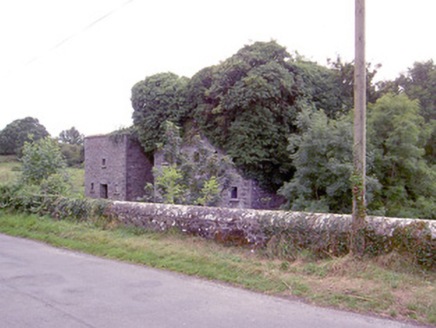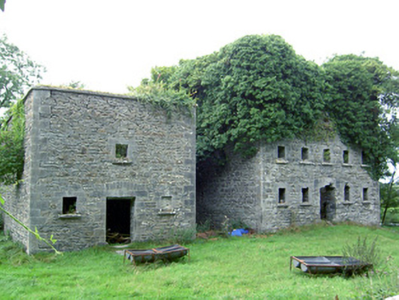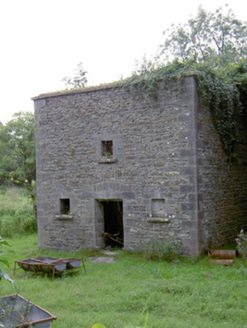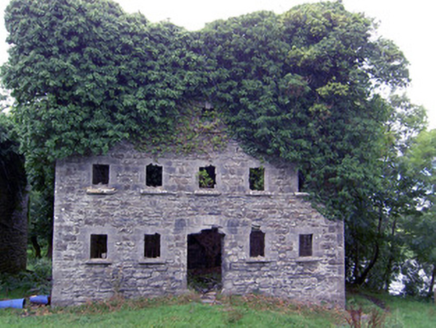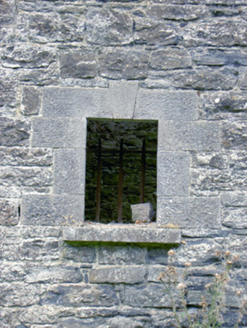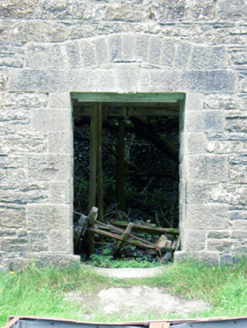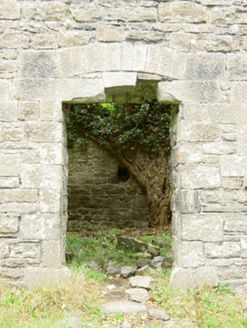Survey Data
Reg No
13402351
Rating
Regional
Categories of Special Interest
Architectural, Technical
Original Use
Mill (water)
Date
1850 - 1870
Coordinates
221420, 258571
Date Recorded
24/08/2005
Date Updated
--/--/--
Description
Former corn mill complex, built c. 1860, comprising a detached five-bay three-storey former corn mill to the north and a detached three-bay two-storey building adjacent to the south, possibly originally a corn kiln. Now out of use and derelict. Roofs now collapsed (probably originally hipped) having cut stone eaves courses to both buildings. Rubble limestone walls with flush squared dressed limestone block-and-start quoins to the corners of both structures. Square-headed window opening having flush dressed limestone block-and-start surrounds with prominent wedge-shaped keystones and having tooled limestone sills. Original window fittings no removed. Square-headed door openings to the centre of the east elevation of both buildings having flush dressed limestone block-and-start surrounds with prominent wedge-shaped keystones over. Segmental-headed relieving arches over both doorways having dressed limestone voussoirs. Set slightly back from road on the south bank of the River Inny, and to the southwest of Clynan Bridge (13402350). Former millrace runs east-west to the north of the former corn mill. Remains of former late medieval castle (LF023-123002-), later converted for use as a corn mill, on the opposite side of the river to the northeast.
Appraisal
This substantial former corn mill complex retains much of its early form and character. The scale of this complex still impresses despite it being roofless and out of use for a considerable period. These utilitarian structures are robustly built in rubble limestone. However, the good quality dressed limestone block-and-start surrounds to the openings and the dressed limestone quoins to the corners are of a quality that is not commonly found on industrial buildings. The contrast between the rubble stone construction and the dressed limestone detailing creates an attractive and interesting textural and tonal appearance to the exterior elevations. This corn mill complex probably dates to the mid-nineteenth century (not indicated on the Ordnance Survey first edition six-inch map of 1838). It is uncommon to find a large-scale corn mill complex built after c. 1815 in rural Ireland, the majority been built between c. 1780 and c. 1815, which was a boom period for the Irish corn milling industry (partially due to effects the Napoleonic Wars which made trade with continental Europe difficult; large corn mills built after c. 1846 are uncommon in rural Ireland following the repeal of the Corn Laws although a number of large-scale mills were built in sea port locations in the late-nineteenth century ). This corn mill is one of a number located along the River Inny close to this location, and there is the remains of a medieval castle (LF023-123002-), later converted for use as a corn mill by the McCann family of Drogheda, c. 1800 - 1810, but now ruinous to the northeast of Cloghan Mills and the remains of another corn mill in the townland of Drumanure to the south of Abbeyshrule. This mill was probably originally built by the Slator family of nearby Clynan House (13402352). It was described as ‘Corn mill, corn kiln and stores’ c. 1860 (Griffiths Valuation – cancelled books), and was in the ownership of an Anne Slator, residing at Clynan House at this time. It may have been founded by Henry Beven Slator, who also ran a corn mill at Ballymahon to the southwest c. 1850. This mill is not mentioned in the Valuation Office Mill Book for County Longford, dated 1854, which strongly hints that this complex was constructed after this date. Cloghan Mills were later in the ownership of a Arthur Slator in 1881, and a Bevan Slator in 1894, described as a miller and corn merchant (both Slater’s Directory). This corn mill is an integral element of the built heritage of the area, and is one of the most impressive surviving nineteenth century mills in County Longford. The remains of the former millrace to the north form an important element of the story of this site, providing an historical insight into past industrial processes.
